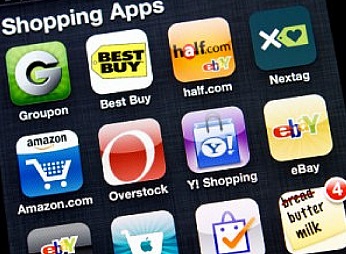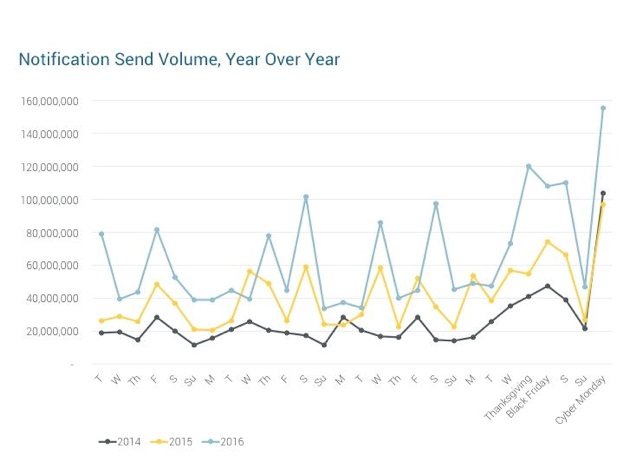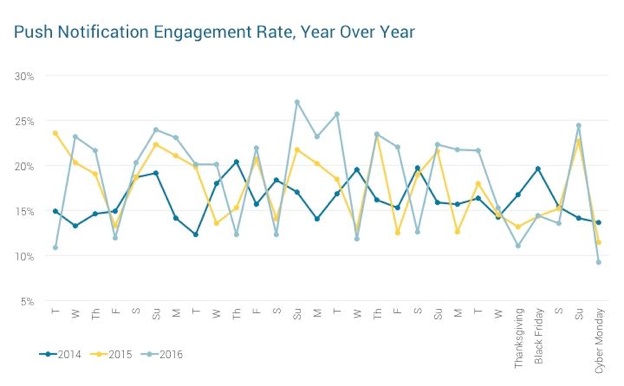netimperative.com

As holiday shopping results are tallied from the Black Friday to Cyber Monday time period, early results show it was a banner year for mobile., with many opting to use retailers apps to grab a bargain, according to new research.
Urban Airship today released preliminary results of its fourth annual Cyber Week study on mobile app engagement using aggregate data from hundreds of retailers’ apps.
Analysis shows retailers promoted holiday deals earlier and at greater scale than years prior, significantly ramping up mobile app messaging two weeks in advance of the big shopping weekend.
Key results include:
• Retailers sent 56% more holiday notifications in 2016 than 2015
• The big difference this year: retailers embraced targeting, 88% of notifications were highly targeted to shoppers’ location, preferences and behaviors and only 12% were broadcast to everyone
• Average notification opt-in rates for iOS apps have continued to grow, reaching 41 percent in 2016, up from 39 percent in 2015
• Daily app installs averaged more than 696,000 per day in November, up 24% from the average daily rate in October
• Black Friday peaked at more than 1.2 million app installs
Analysis shows retailers promoted holiday deals earlier and at greater scale than years prior, significantly ramping up mobile app messaging two weeks in advance of the big holiday shopping weekend.

Retailers sent 56 percent more holiday notifications in 2016 than 2015, and 2015 was a 63 percent increase over 2014 volumes. The big difference this year: retailers embraced targeting. Preliminary Android analysis found 88 percent of notifications were highly targeted to shoppers’ location, preferences and behaviors and only 12 percent of messages were broadcast to everyone. These highly targeted notifications saw engagement rates that were more than three times higher than broadcast messages.
With notification volumes growing each year, consumers have responded with higher average notification engagement rates, reaching 19 percent in 2016, up from 18 percent in 2015 and 16 percent in 2014. In addition, average notification opt-in rates for iOS apps have continued to grow, reaching 41 percent in 2016, up from 39 percent in 2015 and 38 percent in 2014.
Throughout November, notification engagement rates exhibited a similar pattern as past years, where shoppers are most engaged with messages in advance of big shopping days rather than during those days. This year-over-year view vividly shows mobile’s role in pre-shopping research.

Other core findings:
• Daily app installs averaged more than 696,000 per day in November, up 24% from the average daily rate in October.
• Retail app installs spiked above 900k on Thanksgiving and the following Saturday, with Black Friday peaking at more than 1.2 million app installs.
• The gap between high- and low-performing apps is widening. 90th percentile iOS apps see 58 percent of users opted in to receive notifications, while 10th percentile apps have 21 percent of users opted in.
• Similarly, high-performing apps see more than five times greater notification engagement rates than average apps.
“Whether it’s the growing percentage of online sales completed on mobile devices, or mobile’s broader influence on all offline sales, it has never been clearer that mobile is changing how retailers market and how consumers buy,” said Erin Hintz, CMO, Urban Airship. “We’re pleased to see retailers thoughtfully expanding their direct reach to customers and placing more emphasis on mobile, and we look forward to partnering with them on additional mobile growth best practices.”
Further to this, other studies released this week support the success for mobile this year. The National Retail Federation found more people shopped online than in stores for the second year in a row, and mobile drove the majority of visits to retail websites on Black Friday per Adobe. Impact to offline sales is also massive with Deloitte finding digital influences 56 cents of every dollar spent in retail stores and mobile accounts for two-thirds of that $2.1 trillion impact.
Methodology
Urban Airship analysed aggregate mobile app engagement data from more than 200 retailers throughout November 2016. Engagement trends were calculated using the same retailers year-to-year to provide a truly comparative view of mobile’s growth. Analysis included retail apps that had at least 5,000 unique opens in the three months leading up to the study period to ensure a focus on active apps.
No comments:
Post a Comment